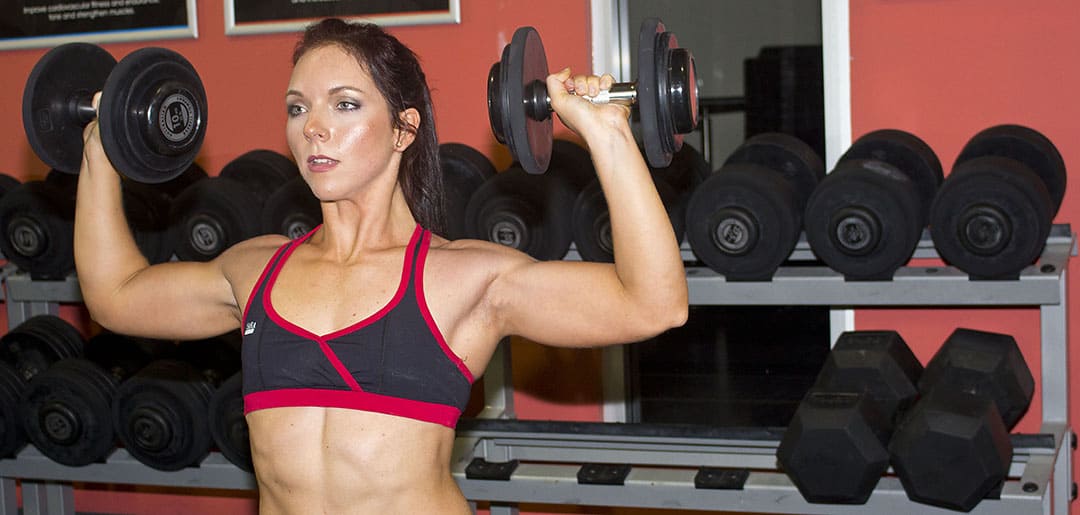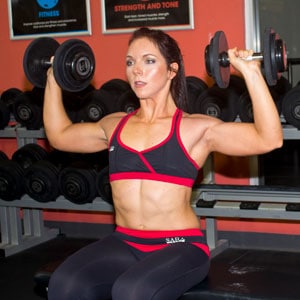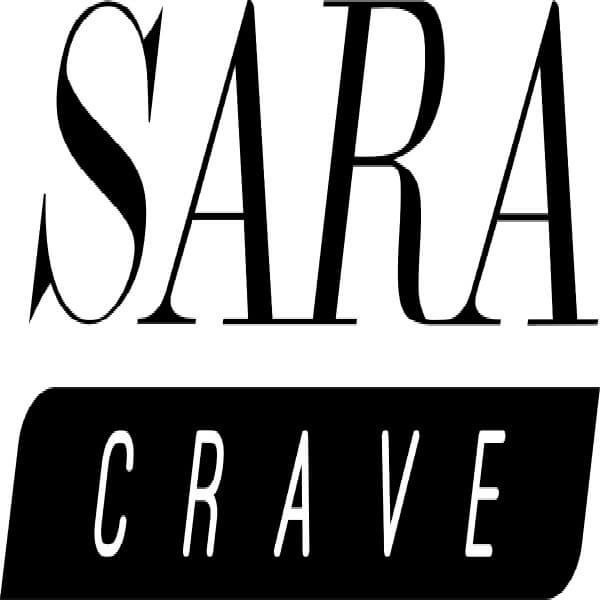- in Fitness Training by Ana Maria

How To Get An Athletes Body: Build An Athletic Body Type
Meet Sarah, a 28-year-old marketing executive who has always been envious of athletes and their toned bodies. She spends hours scrolling through Instagram, admiring the well-defined muscles of fitness models and thinking to herself, 'I wish I had that kind of body.'
But here's the thing: anyone can achieve an athletic body type with dedication and hard work. Building an athletic body doesn't require you to be born with superhuman genetics or have access to fancy equipment – all it takes is discipline and consistency in your training routine.
Yes, it will be harder for some of us, particularly if you've been a couch potato for most of your life, but whatever shape you're currently in, there's no time like today to start working towards an athletic build developing strength and power to get an athletic body.
In this article, we'll discuss how you can get started on building an athlete's body by focusing on key exercises, nutrition habits, and lifestyle changes that will help you reach your goals. So if you're ready to transform your physique and feel like a true athlete, let's dive in!
Do not let your current self-image hold you back. Your future body will thank you!
The Benefits Of An Athletic Body
An athletic body is not just about aesthetics, or how much body fat you have. It comes with a host of benefits that extend beyond the physical appearance and just wanting to look like an athlete.
Improved performance, injury prevention, confidence boost, mental clarity and longevity are some of the many reasons why people aim for an athletic physique.
Improved performance is one of the most significant advantages of having an athletic body type. Having more muscle mass and less fat means you can move faster, jump higher and run farther - resulting in better overall physical abilities.
Also, increased endurance levels mean athletes can go harder for longer periods without feeling exhausted quickly, which is going to help us even if we're not competitive athletes, yes?
Injury prevention is another reason to strive for an athletic body type. People who maintain a healthy weight through exercise are much less likely to suffer from injuries related to overuse or impact compared to those who don't engage in physical activity regularly.
Building strength around joints like hips, knees and ankles helps reduce the risk of strains or tears during workouts or competitions.
But I get it. For lots of people having a body shape that is muscular, athletic or fit rather than your current body is the main benefit you'd like to achieve. That's great, but the good news is that once you've put the work in to get to that goal, all the other health benefits both physical and mental will be yours as well.
“If it doesn’t challenge you, it won’t change you.”
– Fred Devito
Understanding Body Types And Athleticism
Athletic bodies are known for their muscular definition, strength, and agility. Achieving this type of physique requires more than just hitting the gym regularly - it involves understanding your body type and employing specific training techniques along with eating the right foods, that cater to your genetic predisposition.
Body composition plays a crucial role in sports performance and overall fitness level. For instance, athletes with an ectomorph body type tend to be leaner but find it difficult to gain muscle mass. On the other hand, individuals with an endomorph body type have a higher tendency to store fat and require consistent effort to maintain or lose weight. Therefore, tailoring workout routines according to different body types is vital when aiming for athletic excellence, or simply to get an athletic body type.
When you want to build an athletic body, you need to focus on compound exercises that target large muscle groups simultaneously while incorporating high-intensity interval training (HIIT). This combination helps build both the strength and endurance needed for optimal sports performance. Additionally, including flexibility and mobility drills can help prevent injuries and improve the range of motion during exercise.
Essential Exercises for Building an Athletic Body:
1. Squats: They engage multiple lower-body muscles while strengthening core stability.
2. Deadlifts: These work on hip extension movements which increase lower-back strength.
3. Bench Press: It targets the chest shoulder triceps all at once.
4. Pull-Ups & Chin-Ups: The best upper back bicep builders.
To further develop an athletic physique, incorporate these essential exercises into your workout plan along with proper nutrition habits like consuming adequate protein intake post-workout session and making sure you get plenty of water to stay hydrated and help your body recover.
Essential Exercises For Building An Athletic Body
To build an athletic body type, it is essential to perform exercises that focus on power plyometrics, core conditioning, agility drills, explosive training and endurance workouts. These types of movements will help you develop the strength, speed, and flexibility needed for sports performance.
Sometimes people (usually guys) focus too much on training part of the body and don't develop a balanced physique. Training upper body, without enough focus on lower body is a classic mistake.
Power Plyometrics involves rapid muscle contractions designed to increase explosiveness in your lower body. Some examples include jump squats and box jumps. Core Conditioning focuses on developing muscles around your abdomen and lower back resulting in a stronger more stable midsection which can improve posture and reduce the risk of injury.
Agility Drills are exercises that require quick changes of direction often used by athletes who play team sports such as basketball or soccer. Explosive Training involves short bursts of intense activity followed by brief periods of rest with the goal being to maximize the output from your cardiovascular system while minimizing fatigue. Endurance Workouts are longer-duration activities usually performed at a lower intensity than explosive training sessions but aim to train your aerobic system through sustained effort over time.
Exercise | Muscles Targeted |
|---|---|
Jump Squat | Quadriceps, Hamstrings, Glutes |
Box Jumps | Calves, Quadriceps |
Plank Hold | Abdominals |
Russian Twist | Obliques |
Ladder Drill | Agility & Coordination |
As you can see from the table above these exercises work together to target multiple muscle groups simultaneously leading to better overall athletic performance. Incorporating all 5 types of exercise into your routine will not only help you attain an athletic body but also enhance your ability to compete at a high level.
It's important to consider how strength training plays an integral role in building an athlete's body type. By focusing on compound exercises like deadlifts, squats or bench presses alongside accessory movements like bicep curls or tricep extensions we can effectively stimulate our muscular growth creating greater strength and size gains ultimately improving our athleticism.
Importance Of Strength Training For An Athletic Physique
Resistance training, also known as strength training, is crucial for athletes looking to build an athletic body type. This type of training involves using weights or other forms of resistance to increase muscle strength and size, building lean muscle.
By incorporating resistance training including explosive lifting into your workout routine, you can improve your overall performance in your sport. Functional fitness, which focuses on movements that mimic real-life activities, is a great way to incorporate resistance training into your workouts.
Whether you need to sprint faster, jump higher or throw and react in an explosive fashion, strength training will help to develop your central nervous system, joints and muscle fibers to perform at your peak.
Functional exercises like squats, deadlifts, and lunges not only help build muscle but also improve balance, coordination, and stability. These types of exercises can also aid in injury prevention by strengthening the muscles surrounding joints.
Power development is another benefit of resistance training for athletes. By increasing muscular power through explosive movements such as plyometrics or Olympic lifts, athletes can improve their ability to perform quick bursts of movement needed in many sports. It's important to note that proper form and technique are essential when performing these types of exercises to avoid injury.
While building muscle through resistance training is key to achieving an athletic body type, it's equally important ensure you get enough rest to allow your body time to recover, and to fuel your body with the right nutrients. In the next section, I'll discuss nutrition and diet tips for optimal results.
Nutrition And Diet Tips To Get An Athletic Body Type
Did you know that proper nutrition and diet play a crucial role in achieving an athletic body? Studies have shown that up to 80% of your results come from what you eat. That's why meal planning is essential for anyone looking to build an athletic body type whether you're going to be a pro athlete or just want an athletic body shape.
To start, focus on macronutrient intake - protein, carbohydrates, and fats. Protein helps repair and rebuild muscle tissue after workouts, while carbs provide energy for exercise and fats aid in hormone regulation. Aim to consume adequate amounts of each nutrient based on your individual needs and activity level.
The lean proteins contained in meats like chicken, beef or fish are best, with some athletes preferring kangaroo meat which is high in protein with very little fat.
Hydration strategies are also important for optimal performance and recovery. Make sure to drink plenty of water throughout the day, especially before, during, and after workouts to stay hydrated.
Incorporating post-workout nutrition within 30 minutes after exercising can help replenish glycogen stores and promote muscle growth. Supplement use may also be beneficial in filling any nutrient gaps or supporting specific fitness goals, which help ensure you've got the energy to train like an athlete.
For a more in depth look at how to get your nutrition right while working towards an athletic body type read the following posts that will take you through much greater detail:
Proper nutrition is key to building an athletic body type; however, it can be challenging to maintain healthy habits amidst busy schedules or cravings for unhealthy foods. In the next section, I will discuss some common barriers people face when trying to achieve their fitness goals and how to overcome them without sacrificing progress.
Overcoming Barriers To Achieving An Athletic Body
Mental obstacles can be one of the greatest barriers to achieving an athletic body. Negative self-talk and doubt can lead to a lack of confidence, which in turn impedes progress towards fitness goals. However, it is important to recognize that mental strength plays just as big of a role in reaching physical achievements. You want to be considered athletic right, but it's important to be realistic as well, and don't fall into the trap of comparing yourself with a top level Olympic athlete who has usually spent many hours daily for many years, usually since they were quite young to develop that level of athleticism. You don't need to compete at the next Olympics to be considered athletic, ok!
You need to work out a good measure of athleticism, and I think these guys have got some good thoughts about that, which are worth a read.
And to track your progress from when you started, which you should do because it will help to keep you motivated once you see results, you should use this handy lean body mass calculator.
Time management is another common obstacle for those striving for an athletic physique. Many people struggle with finding enough time in their day to fit in regular exercise or meal prep. One solution is to prioritize workouts by scheduling them into your daily routine, treating them like any other appointment or meeting, so that over longer periods of time you will get in shape, get stronger and keep progressing towards your ultimate goals.
Injury prevention is crucial when working towards building an athletic body type. Pushing too hard without proper form or technique can result in painful setbacks that can hinder progress. By taking the time to learn the correct form and listening to your body's signals, you can minimize the risk of injury and stay consistent with your workouts.
• Visualize yourself successfully completing each workout
• Set small achievable goals along the way
• Find a workout partner or accountability buddy
• Incorporate variety into your exercises
• Keep track of progress through photos or measurements
Remember, finding motivation is key when overcoming these barriers. Whether it’s envisioning yourself crossing the finish line at a race or feeling confident on vacation, having a clear goal will help drive you forward. With consistency and determination, anyone can achieve an athletic body type - it may not happen overnight but every step counts towards success!
Faq
How Long Will It Take To See Results When Trying To Build An Athletic Body?
Can Someone With A Physical Disability Still Build An Athletic Body?
Is It Necessary To Hire A Personal Trainer To Achieve An Athletic Body?
What Are Some Common Mistakes People Make When Trying To Build An Athletic Body?
How Can Someone Maintain An Athletic Body Once They Have Achieved Their Desired Physique?
Conclusion
Building an athletic body requires commitment, dedication and hard work. While results may not be immediate, with consistent effort over time, you can achieve your desired physique.
It is important to remember that everyone's journey will look different - some may see results faster than others. If you have a physical disability, don't let it discourage you from pursuing an athletic body type. With the right modifications and adaptations, anyone can build strength and endurance.
And while hiring a personal trainer can certainly help guide you on your fitness journey, it is not necessary for success. Remember to avoid common mistakes such as neglecting proper nutrition or over-exercising certain muscle groups.
Finally, once you've achieved your athletic body goal, maintaining it requires continued effort and consistency in both diet and exercise. As they say, 'Rome wasn't built in a day' - but with persistence and determination, your dream of an athletic body can become a reality.



